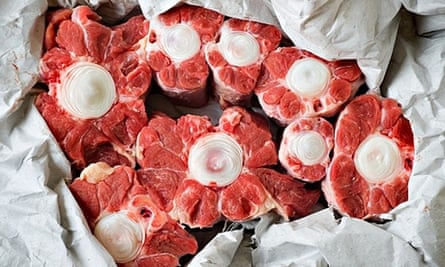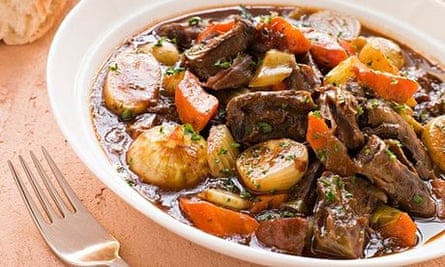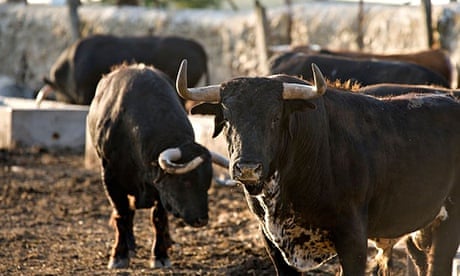La Pepona is one of Seville's most exciting new tapas bars. It is light, airy and trendy, offering natural Andalusian wines and local olive oil. It is, perhaps, not the sort of place you would expect to find such traditional dishes as ragout de toro de lidia – slow-cooked fighting bull meat. But there it is, atop a bed of lightly truffled parmentier.
Restaurateur Juanlu Fernández in no way supports bullfighting, but believes that using the byproduct – the meat – is important, likening it to supporting Andalusian winemakers. "We are in a struggle to defend Andalusian gastronomic culture and recipes against the extreme modernity that is invading us," he says.
And that idea seems to be taking hold. Earlier this year, Seville celebrated Fighting Bull Gastronomic Days, its second annual festival of tapas dedicated to fighting bull meat. Nineteen local chefs competed to create the best simple and gourmet tapas.
But is it possible to separate the idea of the bullfight from the meat? For most of its history, the actual corrida ("run", as the Spaniards call it) was a result of cattle fairs. In much of central and southern Spain, cattle were used primarily for utility, pulling ploughs or transport, and secondarily for beef and milk production, given the low quality of grass found in their semi-arid environment. In every herd there was a proportion of bulls, described as "bravos", who were too aggressive for these purposes and were instead sacrificed in spectacular fashion for public entertainment. Their meat was then used to feed the town as part of the fiesta, providing a rare opportunity for poor rural communities to eat beef.
As the corrida became more popular, some landowners began selecting for the characteristic they called "bravura", or aptitude for the increasingly ritualised bullfight, leading to the development of the ganado bravo, as the breed is known. The trophies that are still awarded to bullfighters after the bull's death (an ear, two ears, a tail) are an echo of its origin in agricultural fairs, when they signified the proportion of the bull's meat the bullfighter was entitled to take home to his family or village, depending on how skillfully he had killed.

In the market of Triana, a district of Seville, specialist butcher Emilio Elena Pozo and his wife Sylvia own the only stall that sells carne de lidia (the meat of the ganado bravo). Because the animals are not reared for meat – the breed exists as a function of the bullfight, so the animals will be killed whether the meat is eaten or not – the beef is relatively cheap, costing on average €10 less a kilo than commercial beef.
With encyclopedic knowledge and obvious passion, they explain that much of their meat comes from animals that never see the inside of the bullring: the breeders select which bulls will go to the ring and which will be kept for breeding, and the rest are sold to an abattoir at the age of two or three (those selected for the bullfight are killed in the ring at three or five). The range of tastes within carne de lidia is very broad, getting increasingly strong and gamey with age, requiring different hanging times and preparation methods.
They have noticed a recent increase in demand for their meat among a new generation of Spaniards with a "gourmet taste for high cuisine". Sylvia tells me she thinks this is because they have had enough of "tasteless commercial meat" and are demanding something they believe to be "different and better".
Restaurateur Ramón López de Tejada would agree – he is one of Seville's most vocal supporters of the quality of ganado bravo meat. He always tries to have off-menu specials of carne de lidia, supplied by Sylvia and Emilio, at his restaurant Antigua Abacería de San Lorenzo.
For experts, the quality of the meat is a result of a better lifestyle. Veterinary surgeon Dr Ismael Díaz Yubero is Spain's former ambassador to the UN's Food and Agricultural Organisation and the author of Gastronomia del Toro de Lidia (The Gastronomy of the Fighting Bull). He argues that this meat is "the most ecological bovine meat produced anywhere in the world".

In Spain, as in many parts of the world, he maintains: "Most beef cattle are killed within a year and a half of birth; their diet is very forced, being designed to make them grow unnaturally fast; and they live in very cramped conditions." By contrast, Díaz Yubero contends that the fighting bulls enjoy a higher quality of life, since their breeders are "aiming to promote health, bravery and vitality so that a select number of the herd can show off their qualities in the bullring".
He believes even those who end up in the ring have a better deal, overall, than commercially raised animals. "For 15 minutes, they undeniably suffer the stress of combat; for the rest of the time they and the rest of their breed are able to enjoy all the pleasures and privileges possible for cattle, roaming in their natural environment among the acorn trees of the dehesa [pasture], and eating their preferred foods."
While animal suffering is, of course, impossible to quantify, Díaz Yubero argues: "The stress that normal beef cattle endure from the time they enter the transport truck to the time spent waiting to be killed at industrial abattoirs is at least comparable." The consensus among those I spoke to was that fighting bulls are transported and kept in far better conditions than industrially farmed animals at a slaughterhouse.
Opponents of bullfighting would disagree, believing the bulls in the ring endure a slow and painful death. And for those who have ethical objections to human selection and utilisation of sentient animals – for labour, consumption or entertainment – whatever its origins or quality of life, eating beef is wrong. The anti-bullfighting Association for the Defence of Animal Rights conceded that while they firmly believe the best course of action is not to eat any meat at all, the worst thing carnivores can do is to eat intensively farmed meat.
With Spain following the worldwide trend for traceable meat and slow food, it is perhaps unsurprising that the meat of the fighting bull is having a renaissance. Bullfighting will, of course, remain contentious, but while it continues, so will its gastronomic byproduct. If the meat isn't sold, the carcasses will simply be burned instead. So for López de Tejada, and many others, whatever their opinions regarding the corrida, we have a duty to treat the meat with as much respect as possible.

Comments (…)
Sign in or create your Guardian account to join the discussion